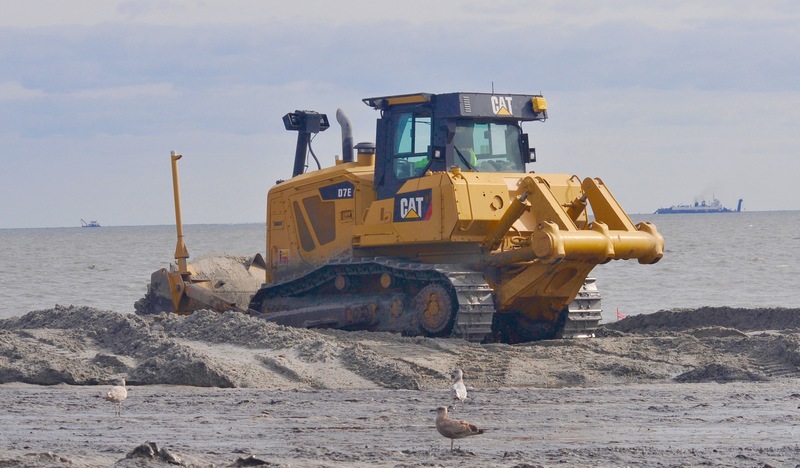Prime Hook National Wildlife Refuge officials walked on a new Fowler Beach this week and marveled at not only its beauty, but also at the new ecosystem taking shape before their own eyes, one that will eventually lead to restoration of the refuge's destroyed marshes.
Two weeks ago, the beach where they were standing was part of the Delaware Bay, which flooded several hundred feet of beach over the past few years.
“This time next year, it should be a different world out here,” said Al Rizzo, project leader for the Coastal Delaware National Wildlife Refuge Complex.
The Fowler Beach area – in the northern section of the refuge – suffered the most damage from a series of storms over the past eight years that pounded the coast, opening four breaches in the shoreline. The breaches allowed free flow of saltwater from Delaware Bay into the marsh, setting off a chain reaction of devastation. One of four marsh impoundments was destroyed and a second was damaged.
Thousands of acres of what used to be freshwater marsh have been changed to open water, drowning out marsh plants.
|
“Our greatest hope is that next May or early June we have horseshoe crabs using this restored beach,” said Al Rizzo, project leader for the Coastal Delaware National Wildlife Refuge Complex. “The grain size of the sand we are using is not that great for human use, but it's perfect for the crabs, and that's what we are all about.”
|
||||
Two dredging projects underway
The bay dredge crew is working 24 hours a day, and simultaneously, another crew is digging 30 miles of channels within the refuge as part of the $38 million restoration project, one of the largest ever attempted along the East Coast.
Since the beach dredging project started less than three weeks ago, about 600 feet of beach has been replenished by a 24-hour dredging crew pumping sand more than a mile off the coast. They are up against a mid-April 2016 deadline.
This week, the Norfolk Dredging Co. crew began to stockpile sand and push it into the widest and deepest breach along the refuge coastline.
The crew is working north to south to fill the breaches, replenish the beach and create a small dune to match the existing beach profile near the village of Primehook Beach.
More than 1.1 million cubic yards of sand will be needed to rebuild the 1.5 miles of beach.
In addition, 10,000 feet of sand fence will be installed in three rows to provide stability along the dune, and 20 acres of spartina will be planted, along with another 38 acres of other vegetation, including beach grass.
A restored beach and dune will offer protection to the marsh. The beachfront will be protected, not only by beach grass but also a vegetated buffer. Officials say that barrier is the key to the sustainability of the project when storms hit the coast.
Rizzo said the beach profile allows for bay water to overwash during major storms. “We are building the beach wide and not high,” he said. “We will need an occasional overwash for the sand and nutrients."
The wide beach profile should allow water to run across the sand, but not open a breach, Rizzo said.
Waiting for nature to take over
Rizzo said when the breaches are filled in and the flow of tidal saltwater is halted, nature can get to work naturally regrowing spartina grass, the foundation of a functioning saltwater marsh. “It gives us a window of time to expose the mud flats so that spartina can recolonize,” Rizzo said. “But, it's not going to happen overnight.”
The goal is to restore most of the refuge to a functioning saltwater marsh. Rizzo said it may take two to three years before the marsh shows signs of major regrowth.
For years, water-control structures in the refuge were used to maintain a freshwater marsh, but the breaches rendered that system unsustainable. When the marsh was inundated with saltwater, grasses failed to grow because of the open water in what refuge officials call the bathtub effect, with little or no water movement.
For spartina and other marsh grasses to grow, the seeds must reach the rich mud and peat of the marsh.
Now that water-control structures are no longer functioning, natural drainage is occurring, the mud flats have returned and regrowth is starting on its own. Channel dredging will provide a source of water to restore marsh grass, and provide small pools and ponds, and allow water flow in and out of the refuge.
Project Manager Bart Wilson said the channels will allow free flow of water from the Broadkill River in the south, and Slaughter Canal and Prime Hook Creek in the north. It's that water moving through 30 miles of channels that will provide the foundation for marsh restoration. Channel dredging in the marsh, moving from south to north, will be ongoing 16 hours a day, six days a week and take about a year.
In addition, the Delaware Department of Transportation plans to construct a 70-foot-long bridge on Prime Hook Road over a new 50-foot-wide channel near the entrance to the community.
The plan includes removal of a section of Fowler Beach Road in the northern section of the refuge and removal of water-control structures. Once the beach restoration project is complete, refuge officials say they want to restore public access to the area with a trail and eventually a boardwalk and observation platform.

































































